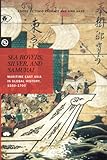Sea Rovers, Silver, and Samurai : Maritime East Asia in Global History, 1550-1700 / ed. by Tonio Andrade, Xing Hang, Anand A. Yang, Kieko Matteson.
Material type: TextSeries: Perspectives on the Global PastPublisher: Honolulu : University of Hawaii Press, [2016]Copyright date: ©2016Description: 1 online resource (396 p.) : 10 b&w illustrationsContent type:
TextSeries: Perspectives on the Global PastPublisher: Honolulu : University of Hawaii Press, [2016]Copyright date: ©2016Description: 1 online resource (396 p.) : 10 b&w illustrationsContent type: - 9780824852764
- 9780824852771
- 380
- online - DeGruyter
- Issued also in print.
| Item type | Current library | Call number | URL | Status | Notes | Barcode | |
|---|---|---|---|---|---|---|---|
 eBook
eBook
|
Biblioteca "Angelicum" Pont. Univ. S.Tommaso d'Aquino Nuvola online | online - DeGruyter (Browse shelf(Opens below)) | Online access | Not for loan (Accesso limitato) | Accesso per gli utenti autorizzati / Access for authorized users | (dgr)9780824852771 |
Frontmatter -- Contents -- Acknowledgments -- Introduction: The East Asian Maritime Realm in Global History, 1500-1700 -- 1. Neither Here nor There: Trade, Piracy, and the "Space Between" in Early Modern East Asia -- 2. Envoys and Escorts: Representation and Performance among Koxinga's Japanese Pirate Ancestors -- 3. Friend or Foe? Intercultural Diplomacy between Momoyama Japan and the Spanish Philippines in the 1590s -- 4. Maps, Calendars, and Diagrams: Space and Time in Seventeenth-Century Maritime East Asia -- 5. Yiguan's Origins: Clues from Chinese, Japanese, Dutch, Spanish, Portuguese, and Latin Sources -- 6. Between Bureaucrats and Bandits: The Rise of Zheng Zhilong and His Organization, the Zheng Ministry (Zheng Bu) -- 7. The Zheng Regime and the Tokugawa Bakufu: Asking for Japanese Intervention -- 8. Determining the Law of the Sea: The Long History of the Breukelen Case, 1657-1662 -- 9. Dreams in the Chinese Periphery: Victorio Riccio and Zheng Chenggong's Regime -- 10. Shame and Scandal in the Family: Dutch Eavesdropping on the Zheng Lineage -- 11. Bridging the Bipolar: Zheng Jing's Decade on Taiwan, 1663-1673 -- 12. The Burning Shore: Fujian and the Coastal Depopulation, 1661-1683 -- 13. Admiral Shi Lang's Secret Proposal to Return Taiwan to the VOC -- 14. Trade, Piracy, and Resistance in the Gulf of Tonkin in the Seventeenth Century -- 15. Koxinga and His Maritime Regime in the Popular Historical Writings of Post-Cold War Taiwan -- 16. Japan in the Chinese Tribute System -- Glossary -- Contributors -- Index
restricted access online access with authorization star
http://purl.org/coar/access_right/c_16ec
Sea Rovers, Silver, and Samurai traces the roots of modern global East Asia by focusing on the fascinating history of its seaways. The East Asian maritime realm, from the Straits of Malacca to the Sea of Japan, has been a core region of international trade for millennia, but during the long seventeenth century (1550 to 1700), the velocity and scale of commerce increased dramatically. Chinese, Japanese, and Vietnamese smugglers and pirates forged autonomous networks and maritime polities; they competed and cooperated with one another and with powerful political and economic units, such as the Manchu Qing, Tokugawa Japan, the Portuguese and Spanish crowns, and the Dutch East India Company.Maritime East Asia was a contested and contradictory place, subject to multiple legal, political, and religious jurisdictions, and a dizzying diversity of cultures and ethnicities, with dozens of major languages and countless dialects. Informal networks based on kinship ties or patron-client relations coexisted uneasily with formal governmental structures and bureaucratized merchant organizations. Subsistence-based trade and plunder by destitute fishermen complemented the grand dreams of sea-lords, profit-maximizing entrepreneurs, and imperial contenders. Despite their shifting identities, East Asia's mariners sought to anchor their activities to stable legitimacies and diplomatic traditions found outside the system, but outsiders, even those armed with the latest military technology, could never fully impose their values or plans on these often mercurial agents.With its multilateral perspective of a world in flux, this volume offers fresh, wide-ranging narratives of the "rise of the West" or "the Great Divergence." European mariners, who have often been considered catalysts of globalization, were certainly not the most important actors in East and Southeast Asia. China's maritime traders carried more in volume and value than any other nation, and the China Seas were key to forging the connections of early globalization-as significant as the Atlantic World and the Indian Ocean basin. Today, as a resurgent China begins to assert its status as a maritime power, it is important to understand the deep history of maritime East Asia.
Issued also in print.
Mode of access: Internet via World Wide Web.
In English.
Description based on online resource; title from PDF title page (publisher's Web site, viewed 29. Jul 2021)


